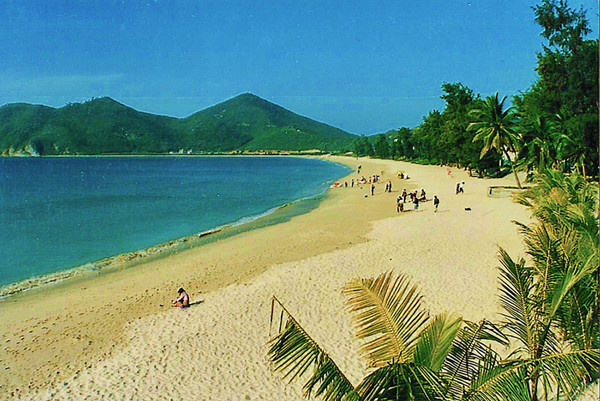
Dadonghai Beach looking to Luhuitou Sanya 1993. [Photo by Bruce Connolly/chinadaily.com.cn]
Most travelers headed directly south by bus to Sanya but I decided to spend several days in Haikou. Historically it was the port for Qiongshan, Hainan's earlier capital, 5 km inland.
Haikou's original harbour partly developed along sheltered Haidian River, a branch of the Nandu between Haidian Island to the north and present day Longhua and Meilan districts. In 1993 it was like stepping back in time. From moored wooden sailing vessels great clay pots of pickled vegetables were unloaded. Boatyards still maintained and even constructed such ships which for centuries had been the mainstay of coastal maritime commerce.
South of the waterway I felt I was walking through the older streets of Malaysia's Penang! This was no mere coincidence. During the Ming and Qing dynasties many Chinese headed to European-colonised ports around the Strait of Malacca. Prospering, some returned to Hainan with wealth to erect distinctive architectural styles referred to as 'Sino-Portuguese' combining Chinese with Arabic and Portuguese characteristics. Most of the older buildings were whitish in -color while supporting ornate window design. Recessed pavements were protected from the weather by overhanging buildings. The sidewalks bustled with maritime-related walk-in shops, buying and selling equipment for the boats. The aroma of spices and traditional medicines along with cooking smells and sizzling sounds from pavement 'fast food' stalls filled the air. Men speaking incomprehensible dialects sat on bamboo stools playing cards or unfamiliar board games while Cantonese cassette music drifted out from scratchy speakers. Women wearing circular bamboo hats navigated bicycle carts loaded with everything from bundles of brushes or fishing nets to baskets of live chickens – surprisingly, Hainan's famed dish is chicken despite these colourful, noisy streets being home to fresh food markets with their large tanks of fish. In earlier days the district was divided into separate zones selling different products. By 1993 it had merged into one great trading area, which I felt was possibly the finest market area I had then come upon in China.